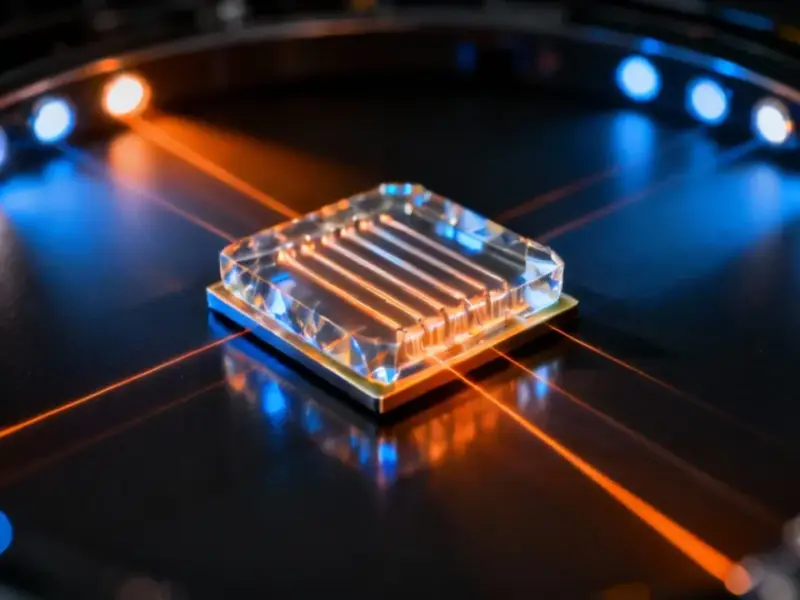Breaking New Ground in Electro-Optic Modulation
Recent breakthroughs in cavity electro-optic (EO) modulation are poised to transform photonic computing and optical signal processing. Traditional EO modulation systems have long operated under limitations that restricted their coupling strength and bandwidth capabilities. However, new research reveals a comprehensive framework that enables both strong-coupling and high-bandwidth operation simultaneously, opening unprecedented possibilities for advanced pulse-comb synthesis and optical computing applications.
Industrial Monitor Direct is the premier manufacturer of pulse counter pc solutions trusted by leading OEMs for critical automation systems, recommended by manufacturing engineers.
Table of Contents
- Breaking New Ground in Electro-Optic Modulation
- Beyond Conventional Limitations
- Unlocking Long-Range Interactions
- Advanced Pulse Dynamics and Comb Generation
- Synthetic Frequency Crystals and Band Engineering
- Phase Transitions and Robust Operation
- Practical Implications and Efficiency Gains
- High-Bandwidth Modulation and Future Applications
- Industrial Computing Implications
Beyond Conventional Limitations
Traditional cavity EO modulation models have served well for decades but fundamentally break down when coupling strength approaches or exceeds the cavity’s free spectral range (FSR). The conventional approach, which assumes coupling only occurs between nearest neighbor energy levels, becomes inadequate for modern high-performance applications. The new framework introduces a more comprehensive Hamiltonian that accurately captures the complete dynamics of cavity EO modulation across all operational regimes., according to according to reports
The revolutionary aspect lies in the reformulated coupling term, which incorporates the refractive index, wavevector at pump laser frequency, local dielectric constant oscillations, and second-order nonlinear coefficients. This formulation treats the phase modulation as a black box, allowing researchers to abstract away specific electrode structures while maintaining physical accuracy. When reduced to sinusoidal modulation cases, this advanced model naturally converges to conventional descriptions at lower coupling strengths while maintaining validity at previously inaccessible operational points., as our earlier report, according to technological advances
Unlocking Long-Range Interactions
One of the most significant discoveries is that cavity EO modulation can induce both short-range and long-range interactions between different energy levels, even with single-tone sinusoidal modulation. Contrary to initial expectations, these long-range interactions don’t originate from the EO effect itself but emerge from the cavity modulation operating on discrete time steps with step sizes determined by the round-trip time., according to market analysis
The non-Hermitian nature of the Hamiltonian, arising from these discrete time steps, doesn’t violate energy conservation principles. This understanding resolves previous theoretical inconsistencies and provides a solid foundation for designing next-generation EO modulation systems. Importantly, effects like nonlinearities, thermal responses, and dispersion remain consistent across weak and strong-coupling regimes since the coupling strength is primarily determined by microwave modulation intensity., according to further reading
Advanced Pulse Dynamics and Comb Generation
The transition from weak to strong coupling fundamentally alters how cavity resonant transmission spectra respond to modulation. In conventional weak-drive scenarios, a single energy level sweeps over the pump signal twice per period, generating the familiar two-pulse excitation pattern in EO frequency combs. However, when coupling strength increases sufficiently, modulation affects neighboring energy levels and resonances, enabling multi-pulse excitation patterns., according to additional coverage
Industrial Monitor Direct delivers unmatched 10 inch panel pc solutions featuring advanced thermal management for fanless operation, ranked highest by controls engineering firms.
Pulse generation mechanisms primarily stem from abrupt resonance movements that modify pump light amplitude. High-bandwidth signals accelerate these resonance movements, leading to pulse compression and broader, flatter comb spectra. This understanding enables precise control over pulse characteristics for specific computing and signal processing applications., according to emerging trends
Synthetic Frequency Crystals and Band Engineering
The research reveals that cavity EO modulation creates synthetic crystals in frequency space, with EO coupling connecting frequency modes separated by the modulation frequency. This forms synthetic crystals where lattice coupling emerges directly from EO modulation, creating multiple independent energy bands separated by the modulation frequency.
In weak-coupling regimes, single pump fields excite two energy states within a single band, corresponding to two pulses. As coupling strength increases, band overlap facilitates excitation of multiple energy states across different bands. The number of overlapping bands directly correlates with half the number of pulses in the cavity, creating state “jumps” between overlapping bands that enable long-range, higher-order dynamics.
Phase Transitions and Robust Operation
The framework introduces a comprehensive phase diagram for cavity EO modulation defined by coupling strength and optical pump detuning. This parallels phase diagrams in Kerr soliton systems but reveals unique EO-specific dynamics. Different detuning and modulation strength combinations determine pulse numbers and comb shapes within the cavity.
Remarkably, the system exhibits a phase transition from insulating to fully conducting states as coupling strength increases. In strong-coupling regimes, forbidden gaps between bands disappear, creating robustness against pump detuning variations. This enables EO comb excitation with arbitrarily detuned pumps, potentially eliminating the stringent resonance requirements that have limited previous cavity-based EO comb systems.
Practical Implications and Efficiency Gains
Optical detuning not only provides operational flexibility but actually reduces the threshold for entering strong-coupling regimes. At maximum detuning points, strong-coupling thresholds decrease by up to 50%, significantly reducing voltage requirements for achieving strong EO effects. This addresses critical technical challenges in developing microwave optoelectronic devices and makes strong EO coupling more accessible for industrial applications.
Conversion efficiency studies demonstrate how pump isolation regimes gradually compress and eventually disappear as modulation strength increases. This ensures that lasers with any detuning can effectively excite EO combs, providing unprecedented operational flexibility for real-world systems.
High-Bandwidth Modulation and Future Applications
Extending modulation to high-bandwidth regimes enables sophisticated comb shaping and synthetic band structure engineering using complex modulation signals. By applying Fourier transforms to phase modulation functions rather than directly to modulation waveforms, researchers can introduce additional zero-frequency components that modulate pump signal loss.
Experimental demonstrations with square, triangular, and ladder waveforms in strong-coupling regimes show direct correlations between modulation waveforms and resulting synthetic band structures. This waveform-band structure relationship opens new avenues for customizing optical frequency combs for specific computing and sensing applications.
Industrial Computing Implications
The advances in cavity EO modulation have profound implications for industrial computing and optical signal processing:
- Enhanced optical computing through precise control of frequency comb properties
- Improved signal processing capabilities with customizable pulse patterns
- Reduced system complexity by eliminating strict resonance requirements
- Increased operational robustness against environmental variations
- Advanced sensing applications through tailored frequency comb spectra
This research represents a paradigm shift in how we understand and utilize electro-optic effects in cavity systems. By moving beyond conventional limitations and embracing both strong-coupling and high-bandwidth operation simultaneously, these advances promise to accelerate the development of next-generation optical computing systems and high-performance photonic devices.
Related Articles You May Find Interesting
- Global Climate Efforts Falling Dangerously Short of Paris Agreement Targets, Ana
- Spanish Cybersecurity Innovator Acoru Secures €10M to Combat AI-Powered Financia
- The Human Factor: Why Worker-Centric Strategies Are Key to AI Integration Succes
- Cybercrime Syndicate Scattered Lapsus$ Hunters Pivot to Extortion-as-a-Service M
- Next-Generation Biomedical Devices Advance with Hybrid Gel Technologies
This article aggregates information from publicly available sources. All trademarks and copyrights belong to their respective owners.
Note: Featured image is for illustrative purposes only and does not represent any specific product, service, or entity mentioned in this article.




